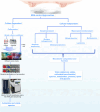Integrating the milk microbiome signatures in mastitis: milk-omics and functional implications
- PMID: 39826029
- PMCID: PMC11742929
- DOI: 10.1007/s11274-024-04242-1
Integrating the milk microbiome signatures in mastitis: milk-omics and functional implications
Abstract
Mammalian milk contains a variety of complex bioactive and nutritional components and microorganisms. These microorganisms have diverse compositions and functional roles that impact host health and disease pathophysiology, especially mastitis. The advent and use of high throughput omics technologies, including metagenomics, metatranscriptomics, metaproteomics, metametabolomics, as well as culturomics in milk microbiome studies suggest strong relationships between host phenotype and milk microbiome signatures in mastitis. While single omics studies have undoubtedly contributed to our current understanding of milk microbiome and mastitis, they often provide limited information, targeting only a single biological viewpoint which is insufficient to provide system-wide information necessary for elucidating the biological footprints and molecular mechanisms driving mastitis and milk microbiome dysbiosis. Therefore, integrating a multi-omics approach in milk microbiome research could generate new knowledge, improve the current understanding of the functional and structural signatures of the milk ecosystem, and provide insights for sustainable mastitis control and microbiome management.
Keywords: Health; Mastitis; Microbiome; Milk; Omics.
© 2025. The Author(s).
Conflict of interest statement
Declarations. Competing interests: The authors have no relevant financial or non-financial interests to disclose. Ethical approval: No ethical approval is required. Consent to participate: Not applicable. Consent to publication: Not applicable.
Figures
Similar articles
-
The bovine milk microbiota: insights and perspectives from -omics studies.Mol Biosyst. 2016 Jul 19;12(8):2359-72. doi: 10.1039/c6mb00217j. Mol Biosyst. 2016. PMID: 27216801 Review.
-
Interrogating the role of the milk microbiome in mastitis in the multi-omics era.Front Microbiol. 2023 Feb 2;14:1105675. doi: 10.3389/fmicb.2023.1105675. eCollection 2023. Front Microbiol. 2023. PMID: 36819069 Free PMC article. Review.
-
Host DNA depletion methods and genome-centric metagenomics of bovine hindmilk microbiome.mSphere. 2024 Jan 30;9(1):e0047023. doi: 10.1128/msphere.00470-23. Epub 2023 Dec 6. mSphere. 2024. PMID: 38054728 Free PMC article.
-
Metagenomic deep sequencing reveals association of microbiome signature with functional biases in bovine mastitis.Sci Rep. 2019 Sep 19;9(1):13536. doi: 10.1038/s41598-019-49468-4. Sci Rep. 2019. PMID: 31537825 Free PMC article.
-
The microbiome of Escherichia coli and culture-negative nonsevere clinical mastitis: Characterization and associations with linear score and milk production.J Dairy Sci. 2019 Jan;102(1):578-594. doi: 10.3168/jds.2018-15062. Epub 2018 Nov 15. J Dairy Sci. 2019. PMID: 30447983
Cited by
-
A Systematic Review on Microbial Profiling Techniques in Goat Milk: Implications for Probiotics and Shelf-Life.Int J Mol Sci. 2025 Jun 10;26(12):5551. doi: 10.3390/ijms26125551. Int J Mol Sci. 2025. PMID: 40565014 Free PMC article. Review.
-
Challenges and Opportunities in Quantifying Bioactive Compounds in Human Breastmilk.Biomolecules. 2025 Feb 24;15(3):325. doi: 10.3390/biom15030325. Biomolecules. 2025. PMID: 40149861 Free PMC article. Review.
References
-
- Abrahamsson TR, Sinkiewicz G, Jakobsson T et al (2009) Probiotic lactobacilli in breast milk and infant stool in relation to oral intake during the first year of life. J Pediatr Gastroenterol Nutr 49:349–354. 10.1097/MPG.0b013e31818f091b - PubMed
-
- Addis MF, Tanca A, Uzzau S et al (2016) The bovine milk microbiota: insights and perspectives from -omics studies. Mol Biosyst 12:2359–2372. 10.1039/c6mb00217j - PubMed
Publication types
MeSH terms
LinkOut - more resources
Full Text Sources
Medical


